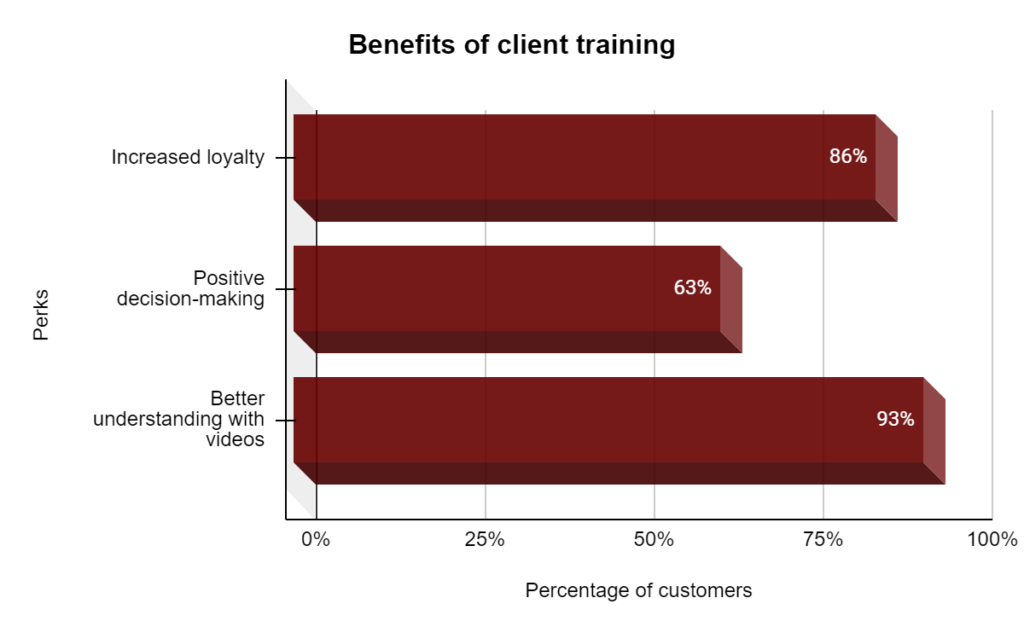What is your “Aha moment”? Your first sales with your customer. Or is it? Let’s pause a moment here. Have you spared a thought for recurring revenue (something that’s related to the customer training cost)? If not, you MUST — NOW. How? A reliable customer onboarding process. It enhances the lifetime value of customers, making them a valuable asset for your business.
Research by the Gartner Group suggests that 80% of a company’s revenue comes from 20% of existing customers. Add to that the fact that a mere 5% increase in customer retention can increase a company’s profitability by 75% – Bain & Co. Hence, there is a massive potential waiting to be untapped!
Table of Contents
How Does a Detailed Customer Onboarding Process Help?
Focus on boosting customer retention and engagement with a comprehensive client onboarding process must be part of your growth strategy — because of its multiple benefits.

Now, you need to answer a few vital questions before altering your strategy. What are the investments involved? How do you calculate and reduce the customer training cost? In short, how can you devise an optimized budget?
For starters, you should begin by segmenting the customer training cost components. One of the vital cost factors in this breakup is customer training. Implementing an end-to-end training model involves time, effort, and cost. However, deploying eLearning can deliver a hugely successful onboarding experience while controlling customer training costs. Therefore, this is the central focus of our article. Let’s get on with it.
Customer Training Cost Breakdown
Research conducted by Forrester Consulting gives you the following numbers:
- The maximum customer training cost for onboarding can reach up to $25,000/client
- The average customer training cost for onboarding is around $6,000/client
- A streamlined onboarding process leads to approx. 30% reduction in the total consumed time

The customer training cost mentioned above depends on a variety of factors. Now, you may incur expenses in any of the following processes that form a part of customer onboarding:
- Content marketing to increase client engagement
- Customer service to address issues faced by buyers
- Technical support: Offering advanced documentation, customer training, and product/service knowledge
- Sales and account management to guide the client through onboarding.
- Analysis & metrics to identify at-risk customers, pinpoint problem areas, and rectify existing issues.
In the form of training materials, technical support enables your customer to additionally helps in tackling barrier points — common pain areas faced by buyers. Product or service walkthroughs ensure that your client stays engaged in the long term.
Yes, training is a tried and tested method, which ascertains a reliable onboarding process. However, it also forms a vital part of the total customer onboarding cost. But you can cut down on this cost by deploying a comprehensive LMS offering an integrated eLearning experience.
Online customer training modules ensure minimized budgets, easy access to knowledge, advanced analytics, among others. Let’s now get to the details.
How Does eLearning Minimize Customer Onboarding Costs?
Training through eLearning, which forms a part of other customer onboarding tools, delivers mutually beneficial results — for you and your buyer. Most importantly, it drastically reduces customer onboarding costs. Here is how.
Short-term Expenses: Long-term Benefits
Several organizations continue to be skeptical about the high development costs involved in setting up eLearning modules. However, this short-term expense far outweighs the long-term benefits. Traditional instructor-led training uses up vast chunks of the training budget in the long run.
eLearning reduces overall training times, translating into increased productivity and profitability. In the conventional customer training model, you will need to take care of your clients’ travel and accommodation, meals, venue rents, and printed learning materials. Not to mention, you also have classroom maintenance costs and salaries for instructors. Updating learning materials consumes not only money but also time and resources.
Incorporating eLearning in the customer onboarding process minimizes the total development cost by doing away with all of the steps mentioned earlier. Since everything is online, you avoid the expenses involved in one-on-one facilitation.
Lower Customer Service Costs
An essential aspect of customer onboarding costs is the expenses related to ongoing silent services. With an eLearning module in place, your clients can access content on-demand, at their own pace and schedule. Now, because of increased comfort levels during knowledge consumption, they will gain more know-how about your products. The result? Less cost and hours spent on customer services!
Moreover, you can further enhance your eLearning modules by embracing a cloud-based system integrated with your course. Single sign-on options ensure that your buyers can instantly and easily get hold of engaging, updated training materials. Lower licensing fees by reputed technology providers leads to lesser ongoing costs.
Reduced Costs in Tracking Customer Progress
It is not sufficient to load your clients with training materials. To track your customer onboarding process’s effectiveness, you must measure if it’s offering any value addition at all. Are your buyers gathering information about your targeted products? Are they using the online knowledge base to solve issues related to your offered services?
Modern eLearning systems, such as PlayAblo, arrive equipped with comprehensive reporting tools. They enable you to measure customer consumption, progress, and engagement levels.
To fit your budget, you must also track the value of your customer training efforts. Moreover, with the tracking tools embedded in the same LMS, you reduce costs in maintaining a real-time view of your clients’ progress.
One LMS Platform: Millions of Customers
With organizations having an increased geographical presence, eLearning is a practical and affordable methodology to cater to millions of customers. With a single LMS installation, you can onboard clients scattered across the globe. Moreover, your customers can have access to multimedia assets, essential to finishing the course. Additionally, you can include presentations, images, video clips, and interactive widgets.
Conclusion
Customer onboarding is vital to decrease customer churn rate. It is the rate at which clients end their relationship with a company. Hence, your solution will have to appear indispensable for that. It will get a significant boost with a cohesive customer training program. But training comes with costs. Therefore, it is vital to choose a system that minimizes your expenses. Perfect opportunity for eLearning to come in!
eLearning courses uploaded into an LMS can support multiple file formats. It means an upfront cost. However, with customer training modules, organizations can significantly reduce expenditures in the long run. So, if your goal is to implement a low-cost, value-added onboarding program, you MUST consider eLearning, ONCE!







I抳e read a few good stuff here. Definitely worth bookmarking for revisiting. I wonder how much effort you put to make such a magnificent informative site.
My buddies on Facebook would find value in this post. Please can I show them?
Thanks for your tips about this blog.
Well I truly enjoyed reading it. This subject provided by you is very useful for good planning.